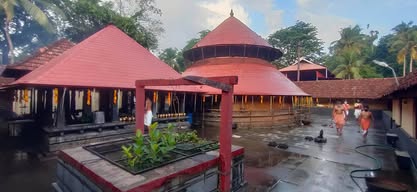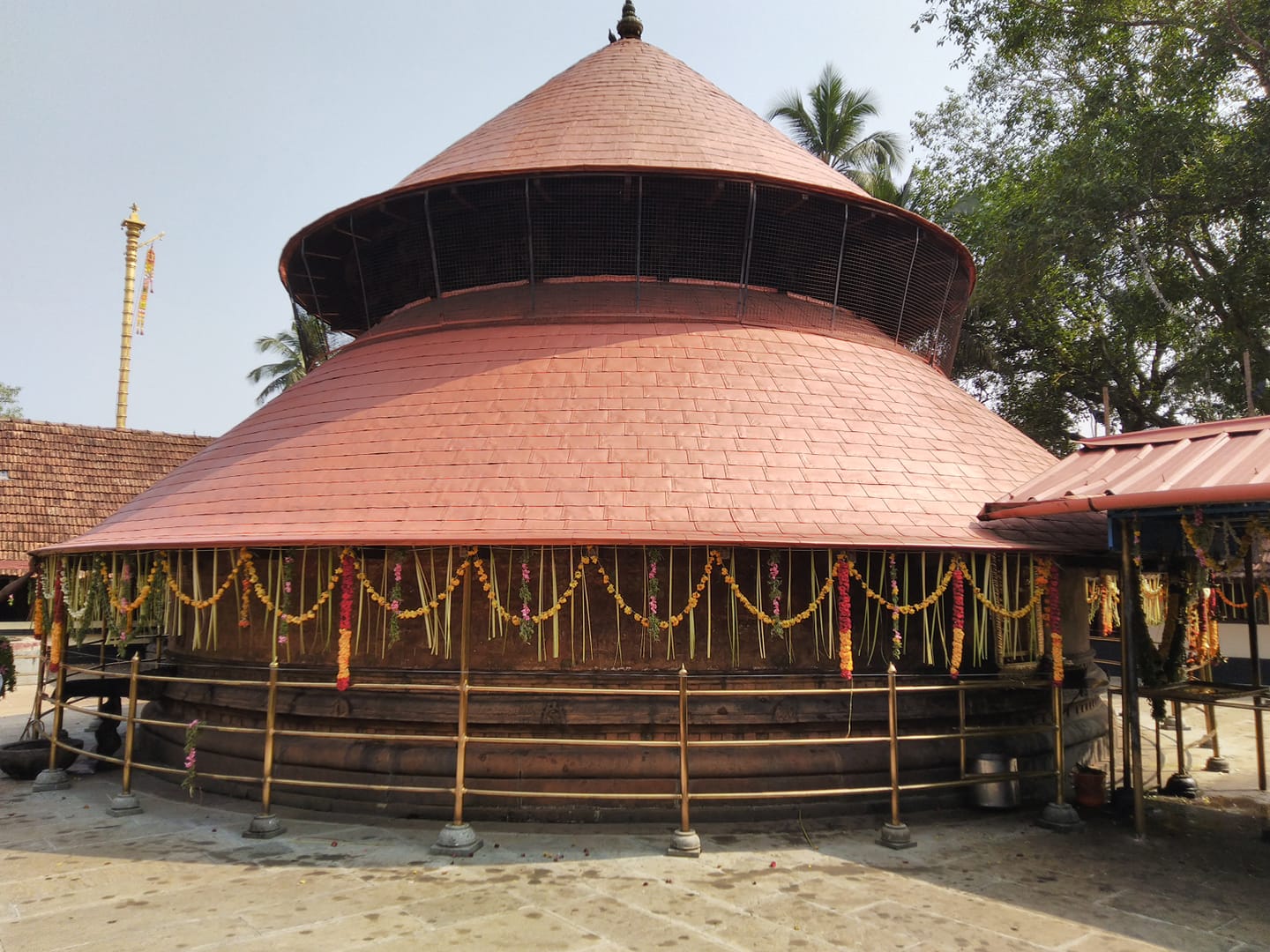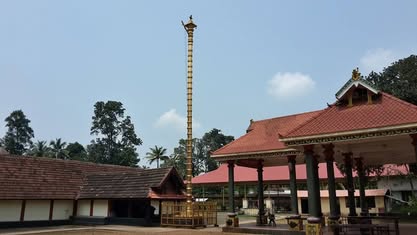Thrikodithanam Mahavishnu Temple is a Hindu shrine situated in Thrikkodithanam, Kottayam District, Kerala. This temple is dedicated to Vishnu, specifically honoring Krishna, an avatar of Vishnu, who is revered as Mahavishnu.

The temple, designed in the traditional Kerala architectural style, is celebrated in the Nalayira Divya Prabandham, an early medieval Tamil scripture composed by the Alvar saints during the 6th to 9th centuries CE. It is one of the five ancient temples located in the Kottayam-Alappuzha-Pathanamthitta region of Kerala, associated with the Mahabharata legend.
According to this legend, each of the five Pandavas is said to have constructed a temple: Yudhishthira built the Thrichittatt Maha Vishnu Temple, Bheema the Puliyur Mahavishnu Temple, Arjuna the Aranmula Parthasarathy Temple, Nakula the Thiruvanvandoor Mahavishnu Temple, and Sahadeva the Thrikodithanam Mahavishnu Temple. The principal deity of the temple is Athpudha Narayanan, also referred to as "Amirutha Narayanan." This deity is depicted in a standing position, oriented towards the east.
His consort is Karpagavalli. The temple exemplifies the architectural style of Kerala. It features a two-tiered gopuram, or gateway tower, with the upper level adorned with wooden trails that cover the Kottupura, the hall designated for drum performances during festivals. Surrounding the temple is a rectangular wall known as Kshetra-Madilluka, which is punctuated by gateways that provide access to the various shrines within the temple complex.
The metal-plated flagpole, or dvajasthambam, along with the Deepastamba, a light post, are aligned with the temple tower, leading towards the sanctum. Chuttuambalam serves as the outer pavilion situated within the temple's walls. The sanctum, along with its adjoining hall, is housed within a rectangular structure called Nallambalam, which features pillared halls and corridors.
A raised square platform known as the Namaskara Mandapa, which features a pyramidal roof, is situated between the entrance of Nallambalam and the sanctum. To the left of the Namaskara Mandapa, as one enters, lies Thevrapura, the kitchen designated for preparing offerings to the deity. Additionally, Balithara serves as an altar for making ritualistic offerings to demi-gods and festive deities.
The sanctum, referred to as Sreekovil, contains the image of the presiding deity and is positioned on an elevated platform, accessible via a flight of five steps leading to a single door. Flanking the door are images of guardian deities known as Dvarapalakas. According to the rituals of Kerala, only the chief priest, termed Thantri, and the secondary priest, known as Melshanthi, are permitted to enter the Sree Kovil.
The central shrine is designed in a circular layout, with a granite base, a laterite superstructure, and a conical roof made of terracotta tiles, all supported internally by a wooden framework. The lower section of the Sree Kovil comprises the basement, the pillar or wall referred to as stambha or bhithi, and the entablature known as prasthara, arranged in a height ratio of 1:2:1.
The upper section of the structure is similarly segmented into three parts: the neck, referred to as griva; the roof tower, known as shikhara; and the finial, kalasam, which is crafted from copper, all proportionately arranged. The roof extends in two tiers to shield the internal framework from the heavy rainfall characteristic of the monsoon season. Lavish wood and stucco carvings adorn the temple roof and several pillars, illustrating various narratives from the ancient epics, including the Ramayana and Mahabharata.
Surrounding the sanctum, the outer walls feature a series of wooden frames that hold numerous lamps, which are illuminated during festive celebrations. The temple's walls are adorned with paintings that date back to the early 18th century. The presiding deity's image stands at 6 feet (1.8 meters) tall, depicting Krishna in the Vishvarupa pose, as he revealed to Arjuna during the Mahabharata war.
In the second precinct, one can find shrines dedicated to Sastha, Yakshi, Nagaraja, and Erangavil Bhagavathy Balarama within the lower shrine. Opposite the temple lies the temple tank, known as Bhoomi Theertham. The roof of the sanctum is referred to as Punniya koti Vimaanam. A peculiar granite statue is situated between the pond and the eastern entrance, adjacent to a public platform dedicated to the arts and discussions.
This statue depicts a man lying flat on his back, rigidly supported by a stone pillar approximately six feet in height. Only his waist makes contact with the pillar, leaving the remainder of his body unsupported. In his left hand, he clutches a shankhu (conch shell) and is adorned with the sacred thread that signifies his Brahmin heritage. Previously, the statue was also crowned. This figure serves as a stern admonition against bribery, deceit, and dishonesty, emphasizing that those who pursue such vices will face severe consequences, akin to the fate of the man depicted on the stone.
Local folklore surrounding this statue recounts tales of jealousy, indiscretion, and swift retribution. The monarch of the Chembakaserry kingdom was a distinguished Nambuthiri Brahmin who took great pride in the flourishing state of his realm and the Sri Krishna temple. Recognizing that temples were vital to both the spiritual and temporal health of a kingdom, the King sought to humiliate the rulers of Nanrulainattu, whose capital was Thrikodithanam, by making an unannounced and inappropriate visit to the renowned Vishnu Temple.
He arrived in Thrikodithanam after the Seiveli puja, which marked the conclusion of the day's ceremonies, and after the temple had closed its doors. It is deemed highly inauspicious to reopen a temple once the deities have been put to rest; nevertheless, the King gained entry by bribing a caretaker. Upon discovering this transgression, the rulers of Nanrulainattu were incensed. The caretaker faced execution, and shortly thereafter, the King of Chembakaserry fell gravely ill and passed away.
Consequently, a stone figure was erected at the temple entrance to dissuade any future violations and to serve as a reminder of the repercussions of disturbing the divine. An alternative version of the tale attributes this clandestine visit to the king of Ambalapuzha. Arputha Narayana temple holds a significant place in the Nalayira Divya Prabhandam, a revered Vaishnava scripture from the 7th to 9th centuries, authored by Nammalvar. It is recognized as a Divya Desam, which refers to one of the 108 Vishnu temples highlighted in this sacred text. Additionally, the temple is thought to be the venue for Kutakkuttu, a traditional dance performed by women who dance while holding an umbrella as part of the worship rituals.
The temple operates daily from 4 am to 10 am and from 4 pm to 7 pm, with the exception of festive days. The two principal festivals observed at the temple are Vaikunta Ekadasi and Thiruvonam. Additionally, the main annual festival spans ten days each year during the month of Karthikai (October/November).
According to tradition, Shiva, in a fit of rage, began to incinerate the area. Brahma implored Shiva to alleviate the situation. Pleased by the display of devotion, Shiva extinguished the flames. To honor this event, the Karthikai festival is celebrated annually at the temple. Gokulashtami and various other festivals associated with Vishnu are also observed here. The temple is managed by the Travancore Devaswom Board.
തൃക്കൊടിത്താനം മഹാവിഷ്ണു ക്ഷേത്രം
തൃക്കൊടിത്താനം മഹാവിഷ്ണുക്ഷേത്രം കോട്ടയം ജില്ലയിൽ ചങ്ങനാശ്ശേരിയ്ക്കടുത്ത് സ്ഥിതിചെയ്യുന്ന ഒരു പ്രശസ്തമായ ദിവ്യക്ഷേത്രമാണ്. മഹാഭാരതത്തിലെ പഞ്ചപാണ്ഡവരുമായി ബന്ധപ്പെട്ട അഞ്ച് വിഷ്ണുക്ഷേത്രങ്ങളിൽ ഇതു ഉൾപ്പെടുന്നു. ചെങ്ങന്നൂർ തൃച്ചിറ്റാറ്റ്, തൃപ്പുലിയൂർ, തിരുവാറന്മുള, തിരുവൻവണ്ടൂർ എന്നിവയാണ് മറ്റ് ക്ഷേത്രങ്ങൾ. പാണ്ഡവരിൽ ഇളയവനായ സഹദേവനാണ് ഇവിടെ പ്രതിഷ്ഠ നടത്തിയതെന്ന് വിശ്വസിക്കുന്നു. മഹാവിഷ്ണുവിന്റെ 108 ക്ഷേത്രങ്ങളിലൊന്നായും സ്വർഗ്ഗീയ വാസസ്ഥലങ്ങളിലൊന്നായും ഇത് കണക്കാക്കപ്പെടുന്നു.
ചങ്ങനാശ്ശേരി പട്ടണത്തിൽ നിന്ന് 2.5 കിലോമീറ്റർ കിഴക്കോട്ട് യാത്ര ചെയ്താൽ ഈ ക്ഷേത്രത്തിൽ എത്തിച്ചേരാം. ഈ ക്ഷേത്രത്തെ സംബന്ധിച്ച ആദ്യകാല രേഖകളും വിവരണങ്ങളും 800-എ.ഡി ക്ക് സമീപം ജീവിച്ചിരുന്ന നമ്മാഴ്വാർ എന്ന ആഴ്വാർ സന്യാസിയുടെ രചനകളിൽ കാണപ്പെടുന്നു. ഈ ക്ഷേത്രത്തിലെ ശിലാലിഖിതങ്ങൾ രണ്ടാം ചേര സാമ്രാജ്യത്തിന്റെ (800-1102 എ.ഡി) കാലഘട്ടത്തിൽ രൂപീകരിക്കപ്പെട്ടതാണ്. [അവലംബം ആവശ്യമാണ്]
തൃക്കൊടിത്താനം മാഹാവിഷ്ണു ക്ഷേത്രം കേരള സർക്കാരിന്റെ കീഴിലുള്ള സ്വയംഭരണ സ്ഥാപനമായ തിരുവിതാംകൂർ ദേവസ്വത്തിന്റെ നിയന്ത്രണത്തിലാണ്. തിരുവിതാംകൂർ ദേവസ്വം ബോർഡ് തിരഞ്ഞെടുത്ത കേരളത്തിലെ 224 പ്രധാന ക്ഷേത്രങ്ങളിൽ ഈ ക്ഷേത്രം ഉൾപ്പെടുന്നു. ഇവിടത്തെ മൂലവിഗ്രഹം അത്ഭുതനാരായണൻ എന്ന പേരിലും അമൃതനാരായണൻ എന്ന പേരിലും അറിയപ്പെടുന്നു. വിഗ്രഹം നിൽക്കുന്ന രൂപത്തിൽ കിഴക്ക് ദിശയിൽ ദർശനം ലഭ്യമാണ്.
അഞ്ജനശിലയിൽ നിർമ്മിച്ച ഈ വിഗ്രഹം, ലക്ഷ്മീദേവി കർപ്പഗവല്ലി എന്ന പേരിൽ അറിയപ്പെടുന്നു. നമ്മാൾവാർ 11 പാശുരാമങ്ങൾ ഇവിടെ ചിട്ടപ്പെടുത്തിയിട്ടുണ്ട്. ഈ സ്ഥലത്തിന്റെ മറ്റൊരു പ്രത്യേകതയാണ് ഭൂമിയിലെ തീർത്ഥമായ പുഷ്കരണിയും പുണ്യകോടിവിമാനവും. ശ്രീകോവിലിന്റെ പടിഞ്ഞാറ് ഭാഗത്ത് മഹാവിഷ്ണുവിന്റെ നാലാമത്തെ അവതാരമായ ഉഗ്ര നരസിംഹമൂർത്തി സമാന പ്രാധാന്യത്തോടെ നിലകൊള്ളുന്നു.
ഉയർന്ന ചുവരുകളും അതിസൂക്ഷ്മമായി കൂട്ടിവിളക്കിയ കല്ലുകളും ഈ ക്ഷേത്രത്തിന് ഒരു കോട്ടയുടെ രൂപം നൽകുന്നു. കൂടാതെ, രണ്ടോ മൂന്നോ ഏക്കറോളം വിസ്തൃതിയിൽ വ്യാപിച്ചിരിക്കുന്ന ഒരു കുളവും ഇവിടെ സ്ഥിതിചെയ്യുന്നു.
പ്രധാന ശ്രീകോവിൽ വൃത്താകൃതിയിലാണ്. രണ്ടുനിലകളുള്ള ഈ ശ്രീകോവിലിന്റെ ഇരുവശങ്ങളും ചെമ്പുമേഞ്ഞതാണ്. അകത്ത് മൂന്ന് മുറികൾ ഉണ്ട്. അവയിലേക്ക് കടക്കാൻ കരിങ്കല്ല് പാകിയ സോപാനപ്പടികൾ കാണാം. പ്രധാനമൂർത്തിയായ ശ്രീമഹാവിഷ്ണുഭഗവാൻ ഈ ശ്രീകോവിലിൽ കിഴക്കോട്ട് ദർശനമായി കിടക്കുന്നു.
മനോഹരമായ അഞ്ജനശിലാവിഗ്രഹം ആറടിയോളം ഉയരത്തിൽ സ്ഥിതിചെയ്യുന്നു, ഇത് ഭക്തരെ ആകർഷിക്കുന്ന ഒരു ആകർഷണമാണ്. ചതുർബാഹുവായ ഭഗവാൻ ശംഖ്, ചക്രം, ഗദ, താമര എന്നിവയെ തന്റെ നാലു കൈകളിലും കൈവശം വഹിക്കുന്നു. പ്രധാന വിഗ്രഹത്തിന് അടുത്തുള്ള സ്ഥലത്ത് ഒരു അർച്ചനാബിംബവും ഒരു ശീവേലിബിംബവുമുണ്ട്, ഇവ ലോഹത്തിൽ നിർമ്മിച്ചവയാണ്. പടിഞ്ഞാറ് ഭാഗത്ത് ഭഗവാന്റെ നാലാമത്തെ അവതാരമായ നരസിംഹമൂർത്തി സ്ഥിതി ചെയ്യുന്നു. അത്യുഗ്രമൂർത്തിയായ നരസിംഹമൂർത്തിയെ പ്രീതിപ്പെടുത്താൻ പാൽപ്പായസത്തിൽ ശർക്കര ചേർത്ത് പ്രത്യേക നിവേദ്യവുമുണ്ട്.
ശ്രീകോവിലിന് മുന്നിൽ ഒരു വിശാലമായ നമസ്കാരമണ്ഡപം സ്ഥിതിചെയ്യുന്നു. ഈ മണ്ഡപം ധാരാളം കൊത്തുപണികളും ശില്പങ്ങളുമാൽ സമൃദ്ധമാണ്, ഉത്സവകാലത്ത് ഇവിടെ കലശപൂജ നടത്തപ്പെടുന്നു. ഇതിന്റെ മച്ചിൽ അഷ്ടദിക്പാലകരും ബ്രഹ്മാവും സന്നിധിയിലുണ്ട്. മണ്ഡപത്തിന്റെ പടിഞ്ഞാറ് ഭാഗത്ത് ഭഗവദ്വാഹനമായ ഗരുഡന്റെ ഒരു ചെറിയ ശില്പം കാണപ്പെടുന്നു, ഇവിടെയും പൂജകൾ നടത്തുന്നു. ശ്രീകോവിലിനുചുറ്റും ധാരാളം ചുവർ ചിത്രങ്ങളും ദാരുശില്പങ്ങളും കാണപ്പെടുന്നു. വിവിധ പുരാണകഥകളിൽ നിന്നുള്ള രംഗങ്ങൾ ഇവയിൽ പ്രത്യക്ഷപ്പെടുന്നു.
ശ്രീരാമപട്ടാഭിഷേകം, ഗണപതിപ്രാതൽ, ദശാവതാരം, പാശുപതാസ്ത്രകഥ, അപ്പം കൊണ്ടുവരുന്ന അന്തർജനങ്ങൾ, അനന്തശയനം, പാർവ്വതീസമേതനായ ശിവൻ, കാളിയമർദ്ദനം, കുവലയപീഡം, പഞ്ചപാണ്ഡവർ എന്നിവ ഇവയിൽ പ്രധാനമാണ്. പ്രധാനശ്രീകോവിലിന്റെ തെക്കുഭാഗത്ത് ദക്ഷിണാമൂർത്തി രൂപത്തിൽ ശിവനും ഗണപതിയും സ്ഥാപിതമായിരിക്കുന്നു. അവരെ കാണാൻ ഒരു ചെറിയ ദ്വാരത്തിലൂടെ മാത്രം നോക്കേണ്ടതുണ്ട്. ഈ പ്രതിഷ്ഠയുടെ പിന്നിൽ ശൈവ-വൈഷ്ണവ സംയോജനം പ്രതിഫലിക്കണം.
ശ്രീകോവിലിന്റെ ചുറ്റും അകത്തുള്ള ബലിവട്ടം നിർമ്മിതമായിരിക്കുന്നു. അഷ്ടദിക്പാലകർ, സപ്തമാതൃക്കൾ, വീരഭദ്രൻ, ഗണപതി, ശാസ്താവ്, സുബ്രഹ്മണ്യൻ, ദുർഗ്ഗ, ബ്രഹ്മാവ്, നിർമ്മാല്യധാരി (ഇവിടെ വിഷ്വക്സേനൻ) എന്നിവരെ പ്രതിനിധീകരിക്കുന്ന ബലിക്കല്ലുകൾ ഇവിടെ കാണപ്പെടുന്നു. ശീവേലിസമയത്ത് ഇവിടെ ബലിതൂക്കുന്നു.
ബലിക്കല്ലുകളിൽ ചവിട്ടുക, കൈതൊട്ട് തലയിൽ വയ്ക്കുക എന്നിവ തെറ്റായി കണക്കാക്കപ്പെടുന്നു. മറ്റ് ക്ഷേത്രങ്ങളിൽ നിന്ന് വ്യത്യസ്തമായി, നിർമ്മാല്യധാരിക്ക് പ്രത്യേക വിഗ്രഹമുണ്ട്. നാലമ്പലത്തിനുപുറത്ത് തെക്കുകിഴക്കുഭാഗത്ത് പടിഞ്ഞാട്ട് ദർശനമായി സുബ്രഹ്മണ്യസ്വാമിയുടെ പ്രതിഷ്ഠ കാണപ്പെടുന്നു. ശ്രീസുബ്രഹ്മണ്യസ്വാമി, രണ്ടുകൈകളിൽ വേലയും വരദമുദ്രയും കൈവശം വഹിച്ചിരിക്കുന്ന ഈ പ്രതിഷ്ഠ, പ്രധാനക്ഷേത്രം വരുന്നതിന് മുമ്പേ ഇവിടെ സ്ഥാപിക്കപ്പെട്ടതാണെന്നും പിന്നീട് നിലവിലെ സ്ഥാനത്തേക്ക് മാറ്റിയതാണെന്നും പറയപ്പെടുന്നു.
തെക്കുപടിഞ്ഞാറുഭാഗത്ത് കിഴക്കോട്ട് അയ്യപ്പസ്വാമിയും നാഗദൈവങ്ങളും ദർശനമാകുന്നു. അയ്യപ്പസ്വാമിയുടെ ശ്രീകോവിലിന് പ്രത്യേകമായി ഒരു മണ്ഡപം നിർമ്മിച്ചിരിക്കുന്നു. മണ്ഡലകാലത്ത് 41 ദിവസത്തോളം ഇവിടെ അയ്യപ്പൻപാട്ടും ആഴിപൂജയുമുണ്ടാകും. നാഗദൈവങ്ങൾക്ക് എല്ലാ മാസവും ആയില്യം നാളിൽ പൂജ നടത്തപ്പെടും.
വടക്കുപടിഞ്ഞാറ് ഭാഗത്ത് ശ്രീ ഭദ്രകാളിയുടെ സാന്നിധ്യം നിലനിൽക്കുന്നു. ഇവിടെ വിഗ്രഹം ഇല്ല. മണ്ഡലകാലത്ത് നടക്കുന്ന കളമെഴുത്തും പാട്ടും ഗുരുതിതർപ്പണവും വഴി ഭഗവതിയെ ആഹ്വാനിക്കുന്നു. തിരുമാന്ധാംകുന്നിലമ്മയുടെ സങ്കല്പം ഇവിടെ ഭഗവതിയ്ക്ക് സമർപ്പിച്ചിരിക്കുന്നു. വിവിധ ദോഷങ്ങളുള്ളവർ ഇവിടെ വന്നു ഭഗവതിയെ വന്ദിക്കുന്നു.
ഈ ക്ഷേത്രം പാണ്ഡവരിൽ ഇളയവനായ സഹദേവനാൽ നിർമ്മിച്ചതും ആരാധിക്കപ്പെട്ടതുമാണെന്ന് വിശ്വസിക്കപ്പെടുന്നു. ഇതിന്റെ പശ്ചാത്തലത്തിൽ ഒരു ഐതിഹ്യം ഉണ്ട്: ശ്രീകൃഷ്ണന്റെ സ്വർഗ്ഗാരോഹണത്തിന് ശേഷം, പാണ്ഡവർ, മൂന്നാമനായ അർജുനന്റെ പൗത്രനായ പരീക്ഷിത്തിനെ രാജ്യം കൈമാറി, ദ്രൗപദീസമേതരായി തീർത്ഥാടനത്തിനായി പുറപ്പെട്ടു. ഈ യാത്രയിൽ അവർ നിരവധി സ്ഥലങ്ങൾ സന്ദർശിച്ചു. കൂട്ടത്തിൽ അവർ ഭാർഗ്ഗവക്ഷേത്രത്തിലേക്ക് എത്തുകയും ചെയ്തു.
തങ്ങളുടെ തേവാരമൂർത്തികളെ ഉചിതമായി ക്ഷേത്രത്തിൽ സ്ഥാപിക്കാൻ അവർ തീരുമാനിച്ചു. അതനുസരിച്ച്, മൂത്തവനായ യുധിഷ്ഠിരൻ ചെങ്ങന്നൂരിലെ തൃച്ചിറ്റാറ്റിലും, രണ്ടാമനായ ഭീമസേനൻ അടുത്തുള്ള തൃപ്പുലിയൂരും, അർജുനൻ തിരുവാറന്മുളയിലും, നാലാമനായ നകുലൻ തിരുവൻവണ്ടൂരിലും പ്രതിഷ്ഠ നടത്തി. എന്നാൽ, സഹദേവനു മാത്രം സ്വന്തമായി വിഗ്രഹമുണ്ടായിരുന്നില്ല. അദ്ദേഹം ഈ സാഹചര്യത്തിൽ തീയിൽ ചാടി ആത്മഹത്യ ചെയ്യാൻ തീരുമാനിച്ചു. അപ്പോൾ അഗ്നിദേവൻ അവന്റെ മുമ്പിൽ പ്രത്യക്ഷപ്പെട്ടു, ദിവ്യമായ വിഷ്ണുവിഗ്രഹം സഹദേവന് സമ്മാനിച്ചു. പിന്നീട്, തന്റെ ജ്യേഷ്ഠന്മാരുടെ പ്രതിഷ്ഠകളിൽ നിന്ന് കുറച്ച് അകലെ, തൃക്കൊടിത്താനത്ത് അദ്ദേഹം വിഗ്രഹം സ്ഥാപിച്ചു.
കിഴക്കേ നടയ്ക്കും ക്ഷേത്രക്കുളത്തിനും മദ്ധ്യേ ആറടി ഉയരമുള്ള ഒരു കരിങ്കൽത്തൂണും, അതിന്റെ മുകളിലായി പൂണൂൽധാരിയായ ഒരാൾ ഇടതുകൈയിൽ ഒരു ശംഖുമായി കിടക്കുന്ന കൃഷ്ണശിലയിൽ നിർമ്മിച്ച ഒരു ആൾരൂപവുമുണ്ട്. ഇതിന്റെ പശ്ചാത്തലത്തിൽ ഒരു കഥ ഉണ്ട്: പണ്ടുകാലത്ത് അമ്പലപ്പുഴ രാജ്യം ഭരിച്ചിരുന്ന ചെമ്പകശ്ശേരി രാജാവ് ജന്മത്തിൽ ബ്രാഹ്മണനായിരുന്നെങ്കിലും വളരെ ക്രൂരമായ പ്രവർത്തനങ്ങൾ നടത്തിയ വ്യക്തിയായിരുന്നു. ഒരു ദിവസം, അദ്ദേഹം ശീവേലി കഴിഞ്ഞു അമ്പലം അടച്ച സമയത്ത് എത്തുകയും ദർശനം നടത്തണമെന്ന് ആവശ്യപ്പെടുകയും ചെയ്തു.
ദേവൻ ഉറങ്ങുകയാണ്, ശല്യപ്പെടുത്തരുതെന്ന് അമ്പലത്തിലെ ആളുകൾ പറഞ്ഞു, എന്നാൽ അദ്ദേഹം ശക്തമായി അമ്പലം തുറക്കുകയും, അപ്പോൾ തന്നെ വീണു മരിച്ചുവന്നു. ആ സംഭവത്തിന്റെ സ്മരണാർത്ഥം, ദുഷ്പ്രവർത്തികൾ ചെയ്യുന്നവർക്ക് ശിക്ഷ ഉടൻ ഉണ്ടാവുമെന്ന് എല്ലാവർക്കും അറിയിക്കുവാനായി മേൽപ്പറഞ്ഞ സ്തൂപം സ്ഥാപിക്കപ്പെട്ടു.
Address:
Ayarkkattuvayal Kailathupady,
Kodunnattukunnu Road,
Changanassery, Kerala 686105



